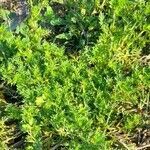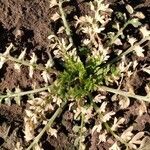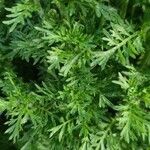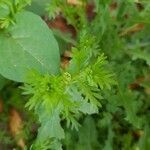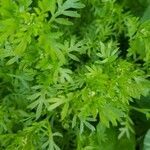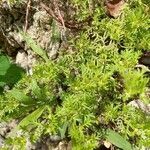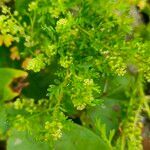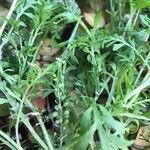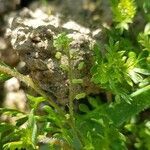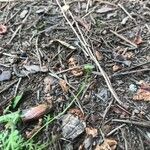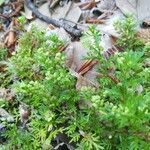Procumbent or erect herbs up to 30 cm high. Stems pilose, glabrescent. Basal leaves up to 9 cm long, pinnatipartite, the segments usually pinnatifid, sometimes only the upper margin of the segments lobed. Upper leaves pinnatifid, smaller. Racemes short and dense in flower, 2-3 cm long in fruit; rhachis pilose. Sepals 0.8-0.9 mm long, greenish white. Petals less than 0.5 mm long, white. Stamens 2 or rarely 4; filaments swollen at the base. Siliculae on spreading or recurved-spreading pedicels 1.5-2.5 mm long, 1.4-1.5 mm long, 2-2.6 mm broad, each half reniform-semicircular, longer than wide, compressed, rounded on the back, reticulately netted and pitted; style always much shorter than the sinus.
Annual or perennial herb 15–30 cm high, prostrate to ascending, glabrous to pilose, foetid. Basal leaves up to 9 cm long, petiolate, pinnatisect with 3–5 (–7) pairs of pinnatifid lobes, to 9 cm long; cauline leaves reducing to sessile and entire. Inflorescence a raceme, exceeding leaves. Sepals 1–2 mm long. Petals shorter than sepals, or absent, white. Stamens 2, rarely 4. Stigma sessile. Silicula 1.5–2 mm long, 2–3 mm wide, bilobed, emarginate (notched) above and below, constricted at septum; valves subglobose, reticulate-pitted, indehiscent but separating into two 1-seeded units; pedicels 1.5–3 mm long. Seeds 1–2 mm long.
A cabbage family herb. It grows 10-70 cm high. It grows for one or two years. It is often a spreading plant lying along the ground. The stems have many branches. The stems are covered with fine long hairs. The stem leaves are divided into leaflets along the stalk. The leaflets vary. The leaves are 2-5 cm long. The leaves are alternate. The plant has a smell like cress when crushed. The flowers are at the end of the plant. The flowers are very small. They may only be 1.5-2 mm across. They have 4 petals. The fruit have 2 rounded sections like two balls close together. These seed pods are 2 mm wide.
Biennial herb, 0.1-0.3 m high, procumbent or erect. Stems pilose, glabrescent. Leaves: basal leaves pinnatipartite, segments pinnatifid, sometimes only upper margins of segments lobed; cauline leaves smaller, pinnatifid. Inflorescence a short, dense raceme; rachis pilose. Sepals greenish white. Petals white. Stamens 2, filaments swollen at base. Flowering time Sept.-Feb. Fruit a siliqua, on recurved-spreading or spreading pedicels, compressed, longer than wide, each half reniform-semicircular, rounded on the back, reticulately netted and pitted.
Biennial herb, up to 0.3 m high. Stems procumbent or erect; pilose. Leaves basally with blade up to 90 mm long, margins pinnatipartite, upper leaves pinnatifid, smaller. Flowers: in dense racemes; sepals 0.8-0.9 mm long, greenish white; petals < 0.5 mm long, white; Sep., Oct. Fruit with spreading or recurved-spreading pedicels; siliquae reniform to subcircular, 1.41.5 x 2.0-2.6 mm, reticulately netted and pitted.
Procumbent or erect herb, up to 300 mm tall. Stems pilose. All leaves pinnatipartite or pinnatifid. Halves of fruits laterally compressed. Flowers white.

